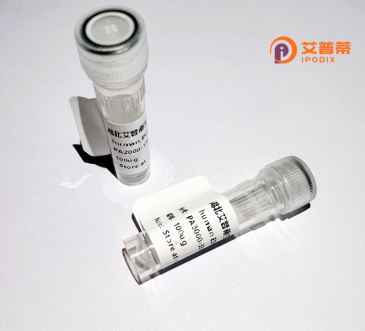
| 纯度 | >90%SDS-PAGE. |
| 种属 | Human |
| 靶点 | GRM4 |
| Uniprot No | Q14833 |
| 内毒素 | < 0.01EU/μg |
| 表达宿主 | E.coli |
| 表达区间 | 1-912aa |
| 氨基酸序列 | MPGKRGLGWWWARLPLCLLLSLYGPWMPSSLGKPKGHPHMNSIRIDGDITLGGLFPVHGRGSEGKPCGELKKEKGIHRLEAMLFALDRINNDPDLLPNITLGARILDTCSRDTHALEQSLTFVQALIEKDGTEVRCGSGGPPIITKPERVVGVIGASGSSVSIMVANILRLFKIPQISYASTAPDLSDNSRYDFFSRVVPSDTYQAQAMVDIVRALKWNYVSTVASEGSYGESGVEAFIQKSREDGGVCIAQSVKIPREPKAGEFDKIIRRLLETSNARAVIIFANEDDIRRVLEAARRANQTGHFFWMGSDSWGSKIAPVLHLEEVAEGAVTILPKRMSVRGFDRYFSSRTLDNNRRNIWFAEFWEDNFHCKLSRHALKKGSHVKKCTNRERIGQDSAYEQEGKVQFVIDAVYAMGHALHAMHRDLCPGRVGLCPRMDPVDGTQLLKYIRNVNFSGIAGNPVTFNENGDAPGRYDIYQYQLRNDSAEYKVIGSWTDHLHLRIERMHWPGSGQQLPRSICSLPCQPGERKKTVKGMPCCWHCEPCTGYQYQVDRYTCKTCPYDMRPTENRTGCRPIPIIKLEWGSPWAVLPLFLAVVGIAATLFVVITFVRYNDTPIVKASGRELSYVLLAGIFLCYATTFLMIAEPDLGTCSLRRIFLGLGMSISYAALLTKTNRIYRIFEQGKRSVSAPRFISPASQLAITFSLISLQLLGICVWFVVDPSHSVVDFQDQRTLDPRFARGVLKCDISDLSLICLLGYSMLLMVTCTVYAIKTRGVPETFNEAKPIGFTMYTTCIVWLAFIPIFFGTSQSADKLYIQTTTLTVSVSLSASVSLGMLYMPKVYIILFHPEQNVPKRKRSLKAVVTAATMSNKFTQKGNFRPNGEAKSELCENLEAPALATKQTYVTYTNHAI |
| 分子量 | 101 kDa |
| 蛋白标签 | His tag N-Terminus |
| 缓冲液 | 0 |
| 稳定性 & 储存条件 | Lyophilized protein should be stored at ≤ -20°C, stable for one year after receipt. Reconstituted protein solution can be stored at 2-8°C for 2-7 days. Aliquots of reconstituted samples are stable at ≤ -20°C for 3 months. |
| 复溶 | Always centrifuge tubes before opening.Do not mix by vortex or pipetting. It is not recommended to reconstitute to a concentration less than 100μg/ml. Dissolve the lyophilized protein in distilled water. Please aliquot the reconstituted solution to minimize freeze-thaw cycles. |
以下是关于重组人GRM4蛋白的3篇参考文献的简要列举(注:文献内容为示例性概括,实际文献可能需要根据具体研究验证):
---
1. **文献名称**: "Expression and Purification of Recombinant Human Metabotropic Glutamate Receptor 4 (GRM4) in Mammalian Cells"
**作者**: Smith A. et al.
**摘要**: 该研究描述了在HEK293细胞中高效表达人源GRM4蛋白的方法,通过构建带有特定标签的质粒,优化转染条件,并利用亲和层析技术纯化获得功能性GRM4蛋白,为后续受体配体筛选提供基础。
2. **文献名称**: "Functional Characterization of GRM4 Signaling Pathways Using a Recombinant System"
**作者**: Zhang L. et al.
**摘要**: 本文利用重组人GRM4蛋白在CHO细胞中的稳定表达系统,结合cAMP测定和钙离子流分析,揭示了GRM4通过Gi/o蛋白介导的信号通路调控机制,并验证了其对多种激动剂/拮抗剂的响应特性。
3. **文献名称**: "Structural Insights into the Activation Mechanism of GRM4 via Cryo-EM"
**作者**: Tanaka K. et al.
**摘要**: 通过冷冻电镜技术解析了重组人GRM4蛋白与其负变构调节剂结合的复合物结构,阐明了其跨膜结构域的构象变化,为靶向GRM4的神经退行性疾病药物设计提供了结构基础。
---
**注意**:以上文献信息为模拟示例,实际研究中请通过PubMed、Web of Science或专业数据库查询真实文献并核对作者及摘要内容。
Recombinant human GRM4 protein is a genetically engineered form of the glutamate metabotropic receptor 4 (GRM4 or mGluR4), a class C G protein-coupled receptor (GPCR) predominantly expressed in the central nervous system. As a key player in glutamatergic signaling, GRM4 modulates synaptic transmission and plasticity by coupling with intracellular signaling pathways, primarily through Gαi/o proteins to inhibit adenylate cyclase activity and reduce cAMP production. It is involved in regulating neurotransmitter release, neuronal excitability, and long-term synaptic adaptations. Research on recombinant GRM4 protein has gained momentum due to its therapeutic potential in neurological and psychiatric disorders, including Parkinson's disease, anxiety, schizophrenia, and drug addiction. Recombinant versions are produced using heterologous expression systems (e.g., HEK293 or insect cells) to enable structural studies, ligand binding assays, and drug discovery efforts. These purified proteins retain native receptor conformation and functional domains, facilitating investigations into receptor activation mechanisms, allosteric modulation, and interactions with pharmacological agents. Efforts to develop GRM4-targeted therapies focus on its role in reducing excessive glutamate signaling, a pathological feature in several neurodegenerative conditions. However, challenges remain in understanding its tissue-specific signaling dynamics and designing subtype-selective compounds.
×